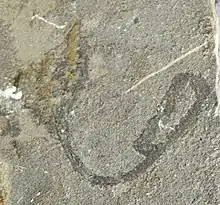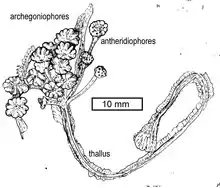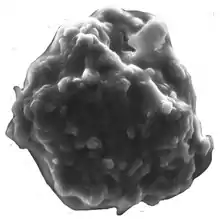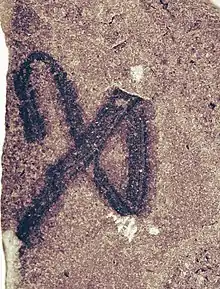Cestites
Cestites ("girdle") was at first considered a ctenophore,[2] but now is regarded as genus of liverwort fossil from the Middle Ordovician (Darriwilian, 460 million years old) Douglas Lake Member of the Lenoir Limestone from Douglas Dam Tennessee.[1]

Thallus of Cestites mirabilis with archegoniophores

Interpretaive sketch of Cestites mirabilis

Spore of Cestites mirabilis
| Cestites | |
|---|---|
 | |
| Holotype of Cestites mirabilis, from Douglas Lake Member of Lenoir Limestone, at Douglas Dam, Tennessee[1] | |
| Scientific classification | |
| Kingdom: | |
| Division: | |
| Class: | |
| Order: | |
| Family: | |
| Genus: | Cestites Caster and Brooks(1956)[2] |
| Type species | |
| Casterlorum crispum Retallack (2019) | |
Description
Cestites has a narrow gametophyte thallus, with a wide midrib and dichotomizing at long intervals. The archegoniophores are parasol shaped and clustered.
Biological affinities
Cestites is similar to living Marchantia.
References
- Retallack, G.J. (2019). "Ordovician land plants and fungi from Douglas Dam, Tennessee". The Palaeobotanist. 68: 1–33.
- Caster, K.E.; Brooks, H.K. (1956). "New fossils from the Canadian–Chazyan (Ordovician) hiatus in Tennessee". Bulletins of American Paleontology. 36: 157–199.
This article is issued from Wikipedia. The text is licensed under Creative Commons - Attribution - Sharealike. Additional terms may apply for the media files.